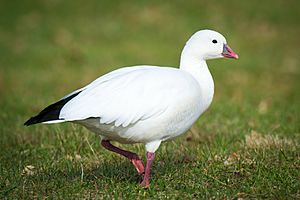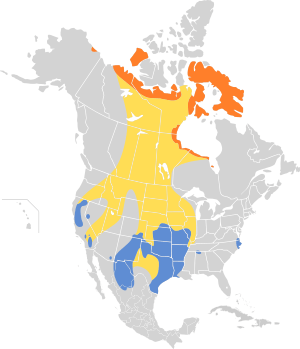Ross's goose facts for kids
Quick facts for kids Ross's goose |
|
|---|---|
 |
|
| Adult Ross's goose in Ohio, USA | |
| Conservation status | |
| Scientific classification | |
| Genus: |
Anser
|
| Species: |
rossii
|
 |
|
| Ross's goose range: Breeding Wintering Migration | |
| Synonyms | |
|
|
The Ross's goose (Anser rossii) is a small white goose. It has black tips on its wings and a short neck. This bird is the smallest of the "white geese" found in North America. It looks a lot like a white snow goose, but it is about 40% smaller.
You can also tell them apart by their bills. The Ross's goose has a smaller bill compared to its body. It also does not have the "black lips" that snow geese often have. It is very rare to see a dark-colored Ross's goose.
A long time ago, before the early 1900s, this goose was quite rare. This was likely because of too much hunting. But thanks to efforts to protect them, their numbers have grown a lot. Today, the IUCN says it is a species of Least Concern. This means it is not in danger of disappearing. The goose is also protected by the Migratory Bird Treaty Act.
The Ross's goose is named after Bernard R. Ross. He worked for the Hudson's Bay Company in Canada. In 1940, people from the Hudson's Bay Company were the first to find where these geese nest in the Arctic.
Contents
What Does a Ross's Goose Look Like?
Ross's geese have a round head and a short neck. Their bill is short and shaped like a triangle. The base of the bill is bluish. It also has small, bumpy growths that become more noticeable as the goose gets older.
Adult geese have all-white secondary feathers on their wings. Young geese, called juveniles, have dark centers on these feathers. Female geese are usually about 6% smaller than males. When they are very young, their legs are olive gray. As they grow up, their legs turn a deep red color.
There are no different types or subspecies of Ross's geese. They are related to other Anser geese. They are especially close to the lesser snow goose. Sometimes, these two types of geese even have babies together.
Size and Weight
Here are some average measurements for Ross's geese:
- Male
- Length: 23.2 to 25.2 inches (59 to 64 cm)
- Weight: 42.3 to 55.3 ounces (1198 to 1567 grams)
- Wingspan: 44.5 to 45.7 inches (113 to 116 cm)
- Female
- Length: 22.6 to 24.4 inches (57.3 to 62 cm)
- Weight: 37.6 to 51.3 ounces (1066 to 1454 grams)
Where Ross's Geese Live
The central Arctic is mostly flat land. It has some rocky areas and drumlins, which are long hills shaped by glaciers. There are also wet meadows and marshy tundra.
The plants in these areas include small dwarf birch trees and willow bushes. You can also find grasses, sedges, and other low-growing plants like crowberry and lapland rosebay. When many birds nest in one place, they can eat a lot of plants. This can cause damage to the vegetation.
Behavior and Life Cycle
Ross's geese build large nesting colonies. They often choose islands in shallow lakes or nearby mainland areas. Their nests are built on the ground using twigs, leaves, grass, moss, and soft feathers called down.
Female geese usually lay about 4 eggs at a time. They sit on the nest to keep the eggs warm for 21 to 23 days.
One study looked at a population of nesting Ross's geese near the McConnell River in Canada. It found about 81,000 nesting geese there.
These birds leave their nesting grounds in Canada by mid-October. They likely move south because food becomes scarce before the cold weather freezes everything. They start to return to their nesting areas in mid-April to May.
Like most geese, Ross's geese are grazers. This means they eat grasses, sedges, and small grains. They often feed in big groups mixed with snow geese.
Protecting Ross's Geese
In the early 1950s, the number of nesting Ross's geese in Queen Maud Gulf was very low. There were only about 2,000 to 3,000 birds. This was because people were hunting and trapping them a lot. They would then sell the geese in markets in California.
To help the geese, hunting them was made illegal in the U.S. in 1931. After this, the number of geese in their wintering areas started to grow again. Later, some limited hunting was allowed again. Today, the Ross's goose is protected by the Migratory Bird Treaty Act.
Images for kids
-
Ross's goose colony in Missisquoi National Wildlife Refuge
See also
 In Spanish: Ánsar de Ross para niños
In Spanish: Ánsar de Ross para niños




